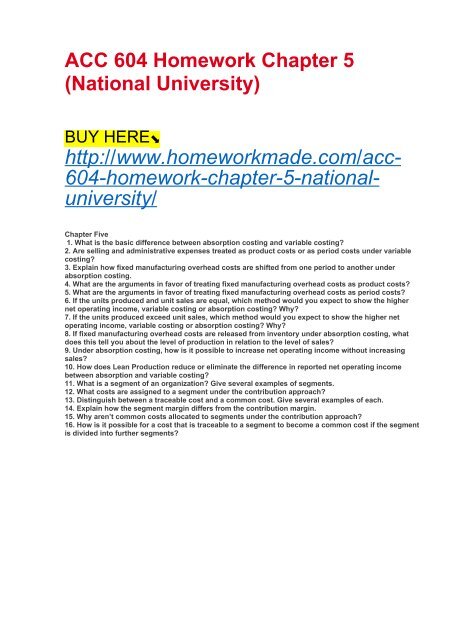ACC 604 Homework Chapter 5 (National University)
- No tags were found...
You also want an ePaper? Increase the reach of your titles
YUMPU automatically turns print PDFs into web optimized ePapers that Google loves.
<strong>ACC</strong> <strong>604</strong> <strong>Homework</strong> <strong>Chapter</strong> 5<br />
(<strong>National</strong> <strong>University</strong>)<br />
BUY HERE⬊<br />
http://www.homeworkmade.com/acc-<br />
<strong>604</strong>-homework-chapter-5-nationaluniversity/<br />
<strong>Chapter</strong> Five<br />
1. What is the basic difference between absorption costing and variable costing?<br />
2. Are selling and administrative expenses treated as product costs or as period costs under variable<br />
costing?<br />
3. Explain how fixed manufacturing overhead costs are shifted from one period to another under<br />
absorption costing.<br />
4. What are the arguments in favor of treating fixed manufacturing overhead costs as product costs?<br />
5. What are the arguments in favor of treating fixed manufacturing overhead costs as period costs?<br />
6. If the units produced and unit sales are equal, which method would you expect to show the higher<br />
net operating income, variable costing or absorption costing? Why?<br />
7. If the units produced exceed unit sales, which method would you expect to show the higher net<br />
operating income, variable costing or absorption costing? Why?<br />
8. If fixed manufacturing overhead costs are released from inventory under absorption costing, what<br />
does this tell you about the level of production in relation to the level of sales?<br />
9. Under absorption costing, how is it possible to increase net operating income without increasing<br />
sales?<br />
10. How does Lean Production reduce or eliminate the difference in reported net operating income<br />
between absorption and variable costing?<br />
11. What is a segment of an organization? Give several examples of segments.<br />
12. What costs are assigned to a segment under the contribution approach?<br />
13. Distinguish between a traceable cost and a common cost. Give several examples of each.<br />
14. Explain how the segment margin differs from the contribution margin.<br />
15. Why aren’t common costs allocated to segments under the contribution approach?<br />
16. How is it possible for a cost that is traceable to a segment to become a common cost if the segment<br />
is divided into further segments?

















